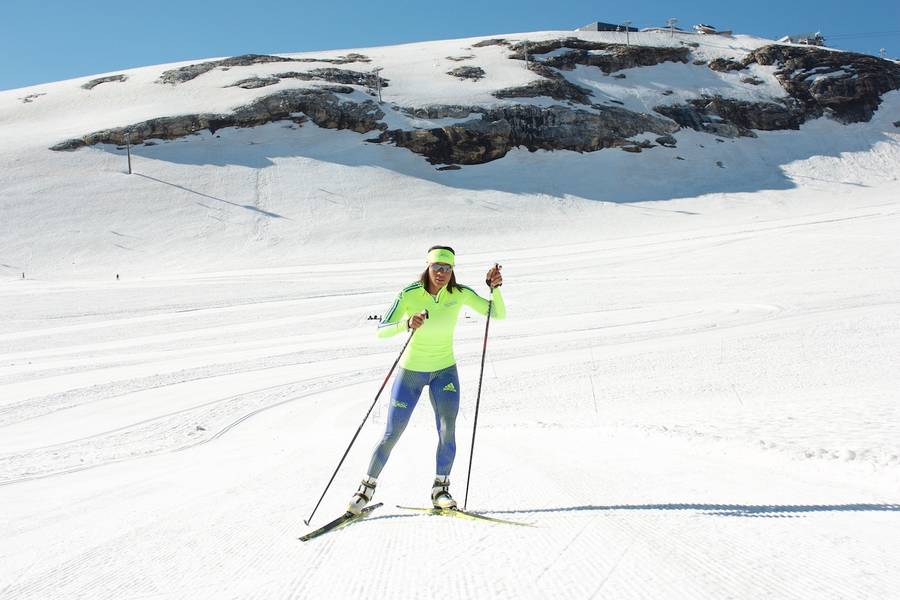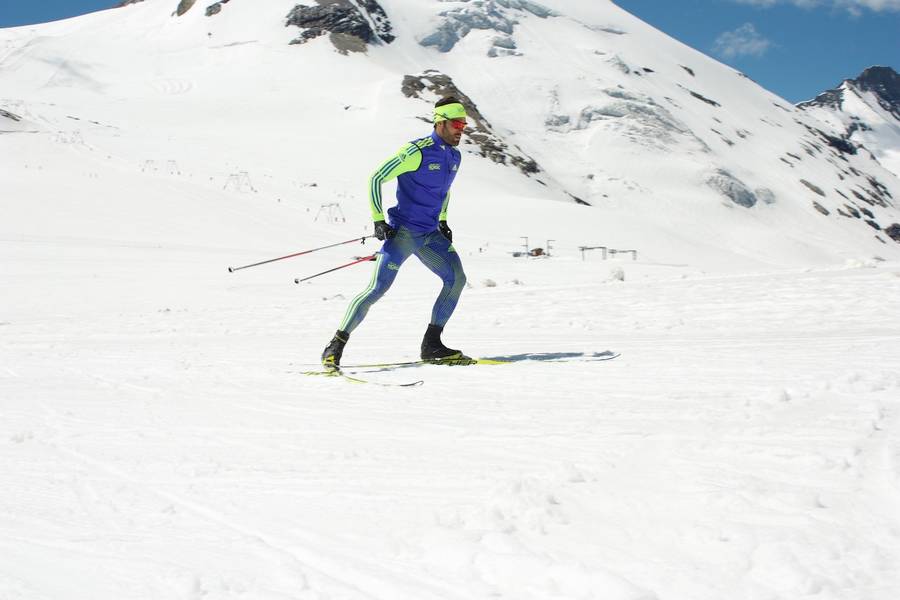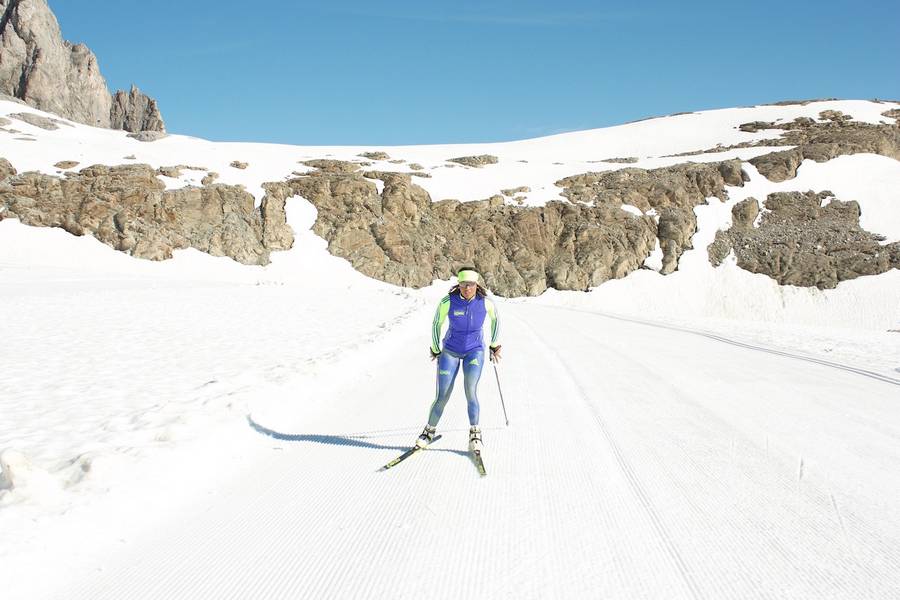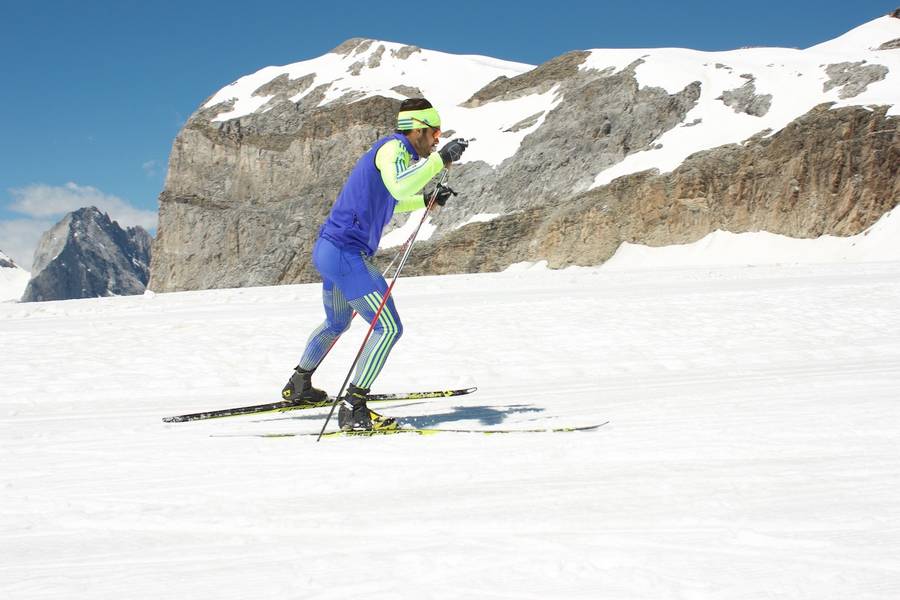How to start cross-country skate skiing?
To start cross-country skate skiing, multiple elements should be considered. First of all, being in good shape is highly recommended. Skating recruits all your muscles, especially the legs and core.
A prior experience in sports such as ice or roller skating can make it easier to apprehend the skating movements.
What to expect of the first sessions?
During the first sessions, it’s essential to learn the basic moves or cross-country skate skiing. It includes learning the skating technique, skating 1-1 and skating 2-2.
- Start with simple exercises such as the half-skate step that allows you to get familiar with pushing on one leg.
- Then, work on transferring your body weight from one leg to the other.
It’s recommended to first practice without poles, to focus on your balance and leg movements.
These first sessions can be unsettling to novice skiers, with patient and practice, you’ll progress fast.
Don’t forget that everyone learns at a different pace, there’s no rush. The key is to learn basic techniques properly.
Physical preparation: tips and advice
For optimal physical preparation for cross-country skate skiing, some targeted exercises can make the difference.
- Strength training: focus on the lower (quads, calves, glutes) and upper body muscles (deltoids, triceps, shoulders) that are highly recruited by this discipline. Exercises such as squats, lunges or even push-ups can be useful.
- Endurance: Do regular cardiovascular activities such as running, cycling, or swimming. Rollerskiing can also be an excellent specific preparation for skating cross-country skiing.
- Flexibility: don’t forget to implement stretching sessions to your training routine to improve your flexibility and prevent injuries.
Finally, a balanced diet and enough sleep are critical for good recovery and effective progression.
Choosing the right equipment as a beginner
To start skate style cross-country skiing, choosing the right equipment is key. Here are a few elements to consider:
- Skis: they must match your weight. You’ll find on our website, weight charts so that everyone can find the right ski for their morphology.
- Boots: they must be comfortable and offer good ankle support. Make sure they’re compatible with your bindings.
- Poles: their lengths must match your morphology. They’re generally shoulder-height.
- Compatibility: make sure your skis, boots and bindings are compatible with each other to prevent any technical issue.
Skating 1-2 with guiding arm:


Skating 1-1:



Skating 2-2 with active arm swing:


Skate diagonally:

The Hop skate:

Basic cross-country skating techniques for beginners
Learning cross-country skating involves a number of basic techniques that you need to master to get the most out of your skiing.
- The basic posture: This consists of standing on your skis with your feet parallel and slightly apart. Your body weight should be distributed evenly between both skis.
- The push: This is a key movement in skating cross-country skiing. You have to push on one leg while sliding on the other. This movement provides the impulsion to move forward.
- Weight transfer: This involves shifting your body weight from one leg to the other as you glide. This technique maintains balance and increases speed.
- Slowing down: Several techniques can be used to slow down, such as snowploughing or skidding.
It's a good idea to start learning to skate cross-country skiing with simple, progressive exercises, such as the skating step and the half-skate step, to master these basic techniques.
Don't forget that practicing often is the key to progressing in cross-country skate skiing.
Basic posture and balance
The basic posture in cross-country skating is the posture to adopt to maintain balance and facilitate movement. It consists of standing on the skis, feet parallel and slightly apart, knees and ankles slightly bent. Your body weight should be evenly distributed on both skis and your pelvis should be positioned above your feet.
To improve your balance, here are a few tips:
- Start by standing on a flat trail with both skis positioned parallel to each other.
- Tilt your ankles forward so that your knees follow.
- Transfer your body weight from one leg to the other, from one ski to the other, to maintain your balance as you glide.
In skating, you can see most skiers, about 90% of them, skating with a bad technique.
Climbing in skating requires a specific technique to optimise the ascent and save energy. This technique, also known as the offset, is based on the 2-2 step. It uses the least energy and comes fairly naturally, making it ideal for beginners.
The side-step is generally used. It involves one arm push for every two leg pushes, but the pole of the dominant arm is planted further forward and with more force.
The hop skate, a staggered-step uphill technique, is generally used by experienced athletes to make the difference in the final climbs of a race or during KO sprints.
Climbing technique for cross-country skate skiing
Climbing in skating requires a specific technique to optimise the ascent and save energy. This technique, also known as the offset, is based on the 2-2 step. It uses the least energy and comes fairly naturally, making it ideal for beginners.
-
The side-step is generally used. It involves one arm push for every two leg pushes, but the pole of the dominant arm is planted further forward and with more force.
- The hop skate, a staggered-step uphill technique, is generally used by experienced athletes to make the difference in the final climbs of a race or during KO sprints.
The downhill skating technique
Downhill skating can provide a good dose of adrenalin, but requires skills to control speed and avoid falls. One of the main aspects is learning how to slow down: several techniques can be used, such as snowploughing or skidding for the more experienced skiers.
The importance of rhythm and timing
In skating, rhythm and timing are essential to optimise glide and the efficiency of each movement. Rhythm, i.e. the rate at which you move, must be regular and synchronised with your breathing. Too fast a pace can lead to exhaustion, while too slow a pace can make you less efficient.
Timing is crucial to the coordination of your movements. For example, the push on the poles must be synchronised with the transfer of weight onto the ski to maximise propulsion. Similarly, precise timing when changing skis helps maintain momentum and balance.
- Rhythm: Regularity, synchronisation with breathing
- Timing: Coordination of movements, maximising propulsion
- Practise specific exercises, focusing on a regular cadence and controlled breathing.
- Use a metronome or constant rhythm music to help you maintain a steady pace.
- Film your training sessions to analyse and correct your movements.
Remember that mastering rhythm and timing takes practice. Be patient and persevere.
Body coordination:
1-1
1-2 with active arm swing
1-2 with guiding arm
Skating training

Finnstep training

Improving in cross-country skating skiing: tips
To progress in cross-country skating skiing, here are some tips:
-
Train often: As with any sport, regular practice is the key to progression. Plan varied training sessions combining endurance, technique, and recovery.
-
Work on your balance: Cross-country skating skiing requires excellent balance control. Off-snow exercises, like yoga or slacklining, can be beneficial.
-
Targeted muscle training: Strengthen the muscle groups used in skating, particularly the core, glutes, quadriceps, and arm muscles.
-
Change techniques: Don't limit yourself to just one stepping technique. Mix it up by alternating between one-step, two-step, staggered, sliding duck, and hop skate.
-
Analyse your technique: Record yourself in action to analyse your technique and identify your mistakes. An external perspective can also be very useful.
-
Take care of your equipment: Regular maintenance of your skis will improve your glide and performance. Don't forget to wax your skis and check the condition of your bindings.
-
Adapt your diet: Cross-country skiing is an endurance sport that requires a suitable diet. Prefer complex carbohydrates before and proteins for recovery.
-
Listen to your body: Don't ignore signs of fatigue and pain. An injury can seriously hinder your progress.
These tips, while general, should help you improve and enjoy cross-country skating skiing even more.
How to choose your training trail?
To choose your training trail, several criteria must be considered. First, identify your skill level and physical condition. For beginners or those in physical recovery, a flat route or one with a gentle slope would be ideal. Next, consider your training goal. If you're focusing on endurance, opt for long, flat trails. For uphill technique, choose trails with gentle ascents. Finally, consider the trail maintenance. A well-groomed trail also offers a better experience.
Safety and rules to follow in cross-country skate skiing
In terms of safety in cross-country skate skiing, some rules are essential to ensure a risk-free practice.
-
Respect other athletes: Each skier must maintain a safe distance from the skier ahead. If stopping, it's essential to move off the tracks to not obstruct other participants.
-
Respect markers and signage: These indicate the direction of the course and any potential dangers on the trail. Never venture onto a closed trail.
-
Control your speed: Adjust your speed to your abilities and the trail conditions. In descents, control your speed to prevent falls.
-
Use suitable equipment: Your skis should combine good stability with perfect manoeuvrability, especially if you're a beginner. Make sure your bindings are properly adjusted to avoid injuries.
-
Maintain good physical condition: Cross-country skate skiing is a demanding sport, ensure you're in good physical shape before hitting the trails.
Remember, respecting these rules guarantees a safe and enjoyable cross-country skate skiing experience for everyone.
Ski safe!
